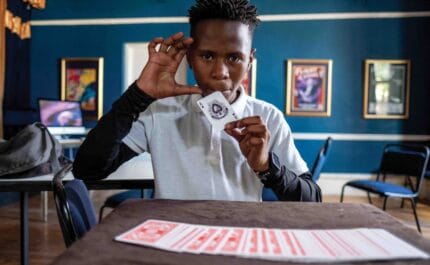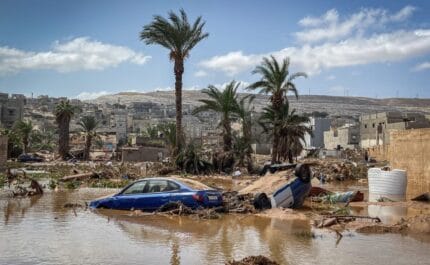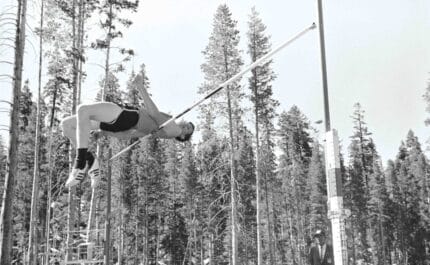A dangerous game
Iran’s World Cup campaign was about far more than football. With protests and violent crackdowns taking place at home, the team’s games in Qatar became a battleground between those looking to highlight atrocities in Iran and those attempting to silence the protesters

Iranian fans hold up signs advocating for women’s rights prior to the World Cup match between England and Iran on 21st November 2022. Photo: Clive Brunskill/Getty Images
21st November 2022 (Taken from: #49)
The music began, and the camera started to move. Slowly it commenced its journey across the faces of the players, from striker Mehdi Taremi to captain Ehsan Hajsafi, as the first notes of the national anthem of the Islamic Republic of Iran rang out across the Khalifa Stadium in Doha. Behind the players a huge inflatable World Cup trophy had been wheeled out, surrounded by a pyrotechnic display that flashed so brightly that the 45,000 spectators could feel the heat of it on their faces in the stands.
It was the opening game for both Iran and England at the Qatar 2022 World Cup finals, one of the most criticised tournaments in sporting history. In much of the western press, the previous weeks had been dominated by the issue of LGBTQ+ rights. In Qatar, homosexual activity is a criminal offence and a handful of teams from western nations including England had threatened to provoke the ire of the hosts, and of the sport’s governing body Fifa, by wearing rainbow armbands during games. The question was whether the English players would back down in the face of threatened sporting sanctions including players being sent off and points deducted. No rainbow armbands were on display when they launched into God Save the King. As the England squad finished singing their newly-amended anthem, another lingering question was about to be answered – would the Iranian players sing theirs?
Just over the Gulf an uprising was entering its second month. A young Iranian-Kurdish woman called Mahsa Amini had died on 16th September 2022, shortly after being picked up by the Gasht-e-Ershad, Iran’s widely detested religious police, for not covering her hair properly. The leaked pictures showing her lying in intensive care breathing through a tube, and her subsequent death, had sparked mass protests against the government and its religious rulers in cities across the country. A defiant revolutionary phrase commonly used by Kurds in the north-west of Iran and beyond swiftly became the slogan of the uprising: ‘Woman, Life, Freedom’. The state responded with extreme violence.
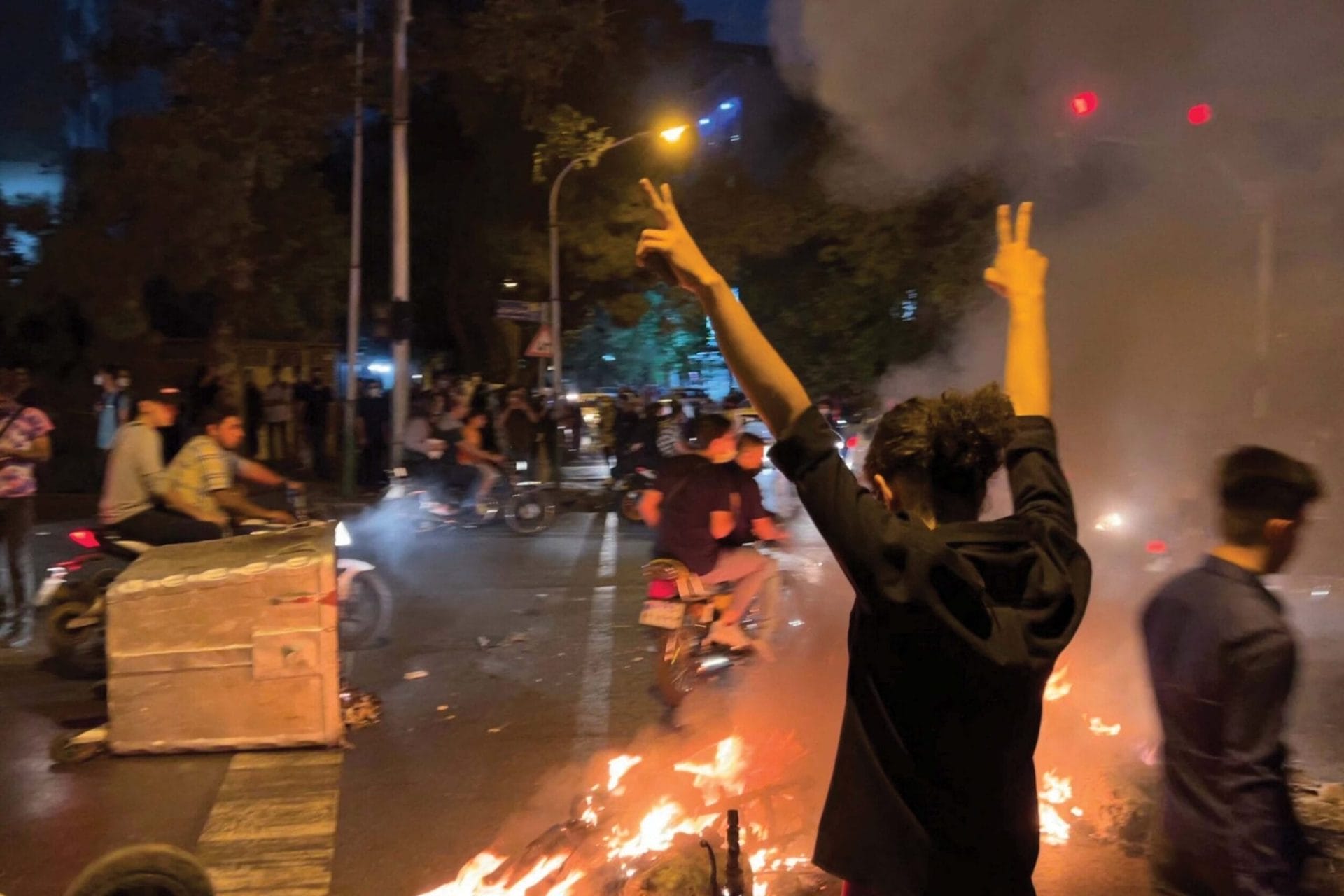
A demonstrator raises his arms and makes the victory sign during a protest for Mahsa Amini in Iran, 19th September 2022. Photo: AFP via Getty Images
By early November, just before the start of the World Cup, the Oslo-based Iran Human Rights group said that at least 326 people had been killed in the uprising, including 43 children. At least 15,000 had been arrested, their fates largely unknown. Reports emerged of widespread torture and sexual violence. The protesters were railing against the restrictions and human rights abuses that have proliferated since the Islamic revolution in 1979 swept an unyielding theocracy to power.
As the protests grew, Iran’s celebrities – actors, poets, musicians and sports stars with massive social media presences – were expected by many Iranians to get off the fence. And Team Melli, as the national football team is known, has long been an avatar for people’s hopes and frustrations, using the relative protection offered by its profile to support myriad issues, from speaking out on the ban on women attending football matches to highlighting endemic corruption within the country. With the World Cup finals in Qatar offering an audience of millions, protesters demanded that the players use their platform to support them too. So at the England game everyone was watching as the Islamic Republic’s anthem was played. Would the players sing? Or would they take a symbolic stand? Whose side were they on?
The music continued and the players stayed silent, their lips unmoving. As the crowd began to process what was happening, some booed while others rejoiced. Thousands began to chant “Bisharaf! Bisharaf!” – ‘dishonourable’ in Farsi. It wasn’t clear whether the chant was directed at the regime for its brutal crackdown or the players for disrespecting the anthem. The response begged another question: which side was the crowd on?
Picking sides
In the weeks running up to the World Cup, the protests in Iran had cast a shadow over Team Melli’s preparations. For the protesters and their supporters in Iran, the tournament was a huge opportunity to tell the world what was really going on. But speaking out against the government can have ruinous consequences in Iran, even for footballers who live abroad. “The government finds different pressure points for each person,” says Sina Saemian, an Iranian football correspondent and regular on the Gol Bezan Iranian football podcast. “Even for the Europe-based players, the majority of their family will still be in Iran.”
To be kicked out of the national team is a small price to pay… viva women of Iran”
Any support from the players in the weeks leading up to the Doha tournament was indirect – not celebrating goals scored in the Iranian league, wearing black wristbands and making broad declarations of support for the Iranian people without mentioning the protests specifically. Even that was sometimes a step too far. Several members of the country’s most successful team, Persepolis, were dragged in for questioning by the Iranian Revolutionary Guards Corps (IRGC), the Islamic Republic’s main military and intelligence arm, after wearing black wristbands during a league match against Tractor.
When the national team travelled to Austria to play a friendly against Senegal in September, the international press reported that Iran’s players were bravely showing their support for the protesters by wearing black jackets during the warm-up. The reality was more prosaic – it was cold. Iranians who supported the demonstrations were furious with the players for how little they had spoken out. It didn’t help when footage was released of the squad smiling and laughing as they met Iran’s hardline president Ebrahim Raisi, the man many blamed for masterminding the state’s crackdown. “I think lots of players felt how disappointed we were in them,” says ‘Sara’, a pseudonym for the founder of Open Stadiums, an activist group that campaigns to end the ban on women attending football matches in Iran. “There was a [temporarily erected] banner on Tehran’s highway that said: ‘When you are dribbling the ball don’t slip on the blood’. These kinds of things are very heavy for the players to carry.” Open Stadiums, like several other human rights groups, had called on Iran to be kicked out of the World Cup. If Russia had been banned by Fifa because of its actions in Ukraine, they reasoned, why not Iran over the callous way it was treating its own people?
One player did publicly proclaim his support for the protests. Sardar Azmoun spoke out on Instagram, where he has five million followers. “The ultimate [punishment for speaking out] is to be kicked out of the national team, which is a small price to pay for even a single strand of Iranian women’s hair. Shame on you for easily killing the people and viva women of Iran. Long live Iranian women!”. Later he posted that he and the rest of the team were being prevented from showing support for the protesters before publicly apologising for his remarks.
According to sources in Iran, the national team’s Portuguese coach Carlos Queiroz was under pressure from the Iranian football federation, which has close links to the government and the IRGC, to drop Azmoun from the World Cup squad. Queiroz had been in a similar position four years before when political pressure was applied to drop his captain Masoud Shojaei. Shojaei had spoken directly to the country’s then-president Hassan Rouhani during a pre-2018 World Cup reception and asked for the ban on women attending football matches to be lifted. He had also played a match for his Greek club against an Israeli team in the Europa League, angering hardliners.
Queiroz delayed announcing his 2022 squad and eventually won the internal argument. Azmoun was on the plane to Doha. Despite Queiroz getting his way on this occasion, Saemian was in no doubt who was ultimately in control. “The Iranian sports ministry are unofficially in charge of [Iran’s football] federation,” he says, even though such naked political control is outlawed by Fifa. Ali Daei and Ali Karimi, two former football greats, also came out in support of the protests – and paid the price. Daei, Iran’s most revered player, who was the all-time leading scorer in men’s international football before Ronaldo overtook his record of 109 goals in 2021, had his passport taken and a travel ban briefly imposed. Several of his businesses were shut down and his family was prevented from leaving Iran. Worse would happen to Karimi, arguably the most talented player in Iranian history. After he managed to flee to Dubai his property and businesses were seized. He was charged in absentia with “assembly and collusion with the intention of acting against national security”. Karimi later claimed that he had been forced to flee after receiving death threats and that a kidnap squad had been sent to the UAE to bring him back to Iran. It is thought he was smuggled to the west, although his exact whereabouts is unknown.
As the World Cup approached, the issue of the Iranian anthem, which is inextricably linked to the Islamic revolution, came to the fore. Iran’s beach soccer team chose not to sing it during a regional tournament. It was a powerful message and the least Iranians expected from Team Melli was to follow suit. “Singing that national anthem, when it is everything that people are fighting against, would be a genuine disappointment,” Saemian told me before the tournament began. “And maybe a little bit heartbreaking as well.”
Iran v England, 21st November 2022
The scene at the Khalifa Stadium was very different to every other Iranian World Cup match I have seen during my many years of reporting on football in the Middle East. At previous World Cups in France, Germany and Russia, the vast majority of Iran supporters were from the diaspora; the sons and daughters of those who had fled Iran before, during and after the revolution. They had mostly been raised in the US and Europe and although proud of their team and their heritage, they were almost all viscerally opposed to the Islamic Republic. The Kurdish flag and the pre-1979 revolution flag of the Shah’s reign, with a golden lion and sun at the centre, were far more widely flown than the country’s official banner. At those World Cups there was a palpable sense of protest and opposition. At France 98, the People’s Mojahedin Organization of Iran (MEK), a leftist anti-Islamic Republic movement, wanted to use the Iran v US game as a platform for protest. But the match against the ‘Great Satan’ (an epithet for the US used by regime leaders in Iran) was so politically explosive that Fifa essentially edited out any banners and mention of them or their cause from the broadcast. Iran won 2-1 and a million Iranians celebrated on the streets of Tehran. It was a victory for the people but the regime couldn’t help but try to make political capital of it. “Tonight, again, the strong and arrogant opponent felt the bitter taste of defeat at your hands,” the supreme leader Ayatollah Ali Khamenei announced in a TV address.
At every Iran game, at every World Cup, I seemed to be surrounded by those with a grievance against the regime”
At the 2006 World Cup in Germany the Iranian team became a lightning rod for protests; young Iranian leftists, feminists, members of the persecuted minority Baha’i and Kurdish communities made their feelings clear before, during and after matches. As did Jewish protesters, who were furious that Iran was allowed to compete, given that the country’s then-president Mahmoud Ahmadinejad was a virulent anti-Semite and Holocaust denier. At Russia 2018, meanwhile, I met Sara and saw other activists protesting outside the Gazprom Arena in St Petersburg against the ongoing ban on women entering Iranian football stadiums. At every Iran game, at every World Cup, I seemed to be surrounded by those with a grievance against the regime. In Qatar things would be different.

Iranian players line up for the national anthem ahead of the match against England at the Khalifa International Stadium on 21st November 2022. Photo: Matthias Hangst/Getty Images
There were far fewer Iranian fans at Khalifa Stadium than at previous tournaments, and the majority of those present were supporters of the regime. The low turnout may in part have been for economic reasons. The expense of flights to Qatar will have deterred some Iranian emigres from flying from Europe and the US. Meanwhile, Iran’s extreme economic crisis will have deterred fans in Iran: the country remains under international sanctions and the Iranian rial has collapsed against the dollar, sparking hyperinflation. But another factor was concerns over safety among those that had vocally opposed the regime in the past. Ever since the Iran-Iraq wars in the 1980s Iran and Qatar have maintained close relations, both politically and economically. The two share the North Dome/South Pars natural gas field, the largest in the world. When Qatar’s Arab neighbours, led by Saudi Arabia and the UAE, ostracised the country in 2017, one of the key justifications was Qatar’s friendly relations with Iran. Saudi Arabia, the spiritual home of Sunni Islam, has long viewed the world’s most populous and powerful Shia state as an existential threat.
Many Iranians I spoke to believed that this relationship meant any attempts to use the World Cup to highlight the protests would be quickly stamped out by the Qatari authorities – or by Iranian forces allowed to operate in the country. Iranian journalists told me that they had been warned by ministry officials before they left not to talk to any foreign journalists. Like the players, they were under constant surveillance by state security officers. Many overseas-based Iranian fans told me they feared they could be kidnapped and sent back to Iran if they attended, as Qatar would give them no political protection.
When a hacking collective leaked an alleged trove of recordings and documents from the Fars News Agency on 25th November, it seemed to prove that these fears were warranted. In several recordings security officials could be heard suggesting how a successful World Cup would divert attention away from the protests. The most damaging claim, though, was that Qatar was closely coordinating with the Iranian government to prevent activists and anti-government journalists from attending. In one recording a man later identified as Qasim Qureshi, the deputy head of the IRGC’s Basij militia, is heard saying: “Qatar has promised us not to let in the people who we name and say their presence is harmful… If you provide documents that we can use as an excuse, [Qatar] will not let them in”. The Qatari authorities said that the information in the recordings was untrue.
I was expecting a lot of people willing to say the name Mahsa Amini… I soon realised that no, we are in the minority”
It certainly felt like there was a degree of crowd control. Several Iranian sources, talking on the condition of anonymity, had told me that as many as 6,000 heavily vetted Iranian fans had flown to Qatar and the Islamic Republic’s flag was the only one permitted to be put on show. Protests were snuffed out by the aggressive security guards and police, although at the first game some messages did get through. Fans were forced to take off any obviously anti-Iranian regime T-shirts. Some supporters noticed that security had allowed T-shirts and placards with the slogan ‘Woman, Life, Freedom’ or the name ‘Mahsa Amini’ on them, as if they didn’t yet know what the political significance of the phrases were. However, those signs were still few and far between.
“When we got into the stadium I was expecting a lot of people willing to say the name Mahsa Amini or ‘Woman, Life, Freedom’ and I soon realised that no, we are in the minority,” says Saeed Kamalinia, a 41-year-old Iranian-American who had flown in from Chicago for the World Cup. Kamalinia left Iran 20 years ago, but he regularly travelled abroad to watch the national squad play, and had always kept Team Melli close to his heart, a little piece of home that connected him to his roots. He had initially considered not coming to Qatar. Some of his friends and family questioned why he was going when blood was being spilled in Iran. But, in the end, Kamalinia felt it was important to support the protests in Qatar. He and his wife managed to sneak a ‘Woman, Life, Freedom’ T-shirt into the game expecting to meet like-minded Iranians. “I would say 80 percent of the crowd were Persian people [supporting the regime], and 20 percent were like us [supporting the protesters],” he says. “And even that 20 percent was scattered.”
You had to look hard to find the small acts of resistance. Some Iranian fans like Kamalinia smuggled in banners anyway, or placed black tape over the Islamic Republic’s flag on their national team jerseys. Then the national anthem began and the crowd reacted, a miasma of booing and cheering. Any time an anti-government chant began, Kamalinia recalls, a host of drummers would drown it out. “I did not feel safe at all,” he says. “Their agenda was to come here, the pro-regime supporters, and show everything was normal.”
In the centre of it all was a group of players – the pressure not just of the World Cup but of the government, their families and the weight of the protesters bearing down on them – taking a stand. The moment clearly took its toll. England were soon 5-0 up and ended up winning the game 6-2. The result provoked a strong reaction from coach Queiroz, who had taken Team Melli to the 2014 and 2018 finals. “Those who come to disturb the team with issues that are not only about football opinions are not welcome,” he said in a combative post-match press conference. He would later confront a female BBC reporter who asked him about human rights in Iran.
I’d interviewed Queiroz four years earlier during an Iranian training camp in Austria. In person he was intense and extremely protective of his players. In public he would go on the attack, lashing out at perceived enemies, especially journalists. It helped create an us-against-them mentality in the dressing room. In the run-up to the England game he had deflected criticism of his players by accusing the British press of trying to play mind games to get a psychological advantage for their team. It wasn’t just the British press on the receiving end either. The day after the England defeat, Queiroz angrily accused the Iranian sports website Varzesh 3 of leaking his team line-up. Later, back in Tehran, Varzesh 3’s editor-in-chief was arrested. He was released a few hours later. “People are very angry with Queiroz,” said Sara from Open Stadiums on the reaction in Iran to Queiroz’s press conference performance. “You cannot talk about the situation like that. He is acting like a mullah now.”
Iran v Wales, 25th November 2022
The game against Wales at the Ahmad bin Ali Stadium was critical to Iran’s hopes of progressing to the second round for the first time. This time the players did sing the anthem. Or, more accurately, they timidly went through the motions, mouthing it with little enthusiasm. The previous day, former international player Voria Ghafouri had been arrested in Iran, charged for social media posts that “tarnished the reputation of the national team” and for spreading “propaganda”. Ghafouri, who played for Team Melli 28 times, had long been outspoken. In January 2023 he was fired as captain of Esteghlal, one of Tehran’s biggest clubs, over his online activism. Like Mahsa Amini, Ghafouri is Kurdish and has criticised the authorities over their treatment of women and girls.
Something had also changed in the crowd. The Qatari police and the security personnel, who had been caught a little off guard by the protest banners at the England game, became much more aggressive. Women who had written the name of dead protesters on their arms, or drawn blood-red tears under their eyes, were forced to scrub them off. “The second game was a different story. We heard that security no longer allowed ‘Mahsa Amini’ t-shirts and flags inside the stadium,” said Arman Jabbari, an Iran fan from Seattle who had also decided to protest. “We wore our ‘Mahsa Amini’ T-shirt and another shirt on top of it. We also hid our flag. Unfortunately, the security guards searched all our clothes and forced us to remove our t-shirt. We were able to sneak our flag past the security check. During the game, as soon as we took out the flag, security guards approached us aggressively and took it away.”
We switched trains multiple times to make sure we were not being followed”
Jabbari, Kamalinia and several female activists I spoke to claimed that government agents were also now following them. “Those people were going around taking pictures, putting people in fear,” said Kamalinia. Almost every time an Iranian gave an interview to the foreign press, they were surrounded and harassed. Kamalinia found two men behind him when he spoke to Voice of America radio, demanding to know how much he had been paid to “betray” his country. According to several activists, groups of Iranian men could be seen pointing out potential government critics to security guards, who were then searched, their flags and T-shirts seized.
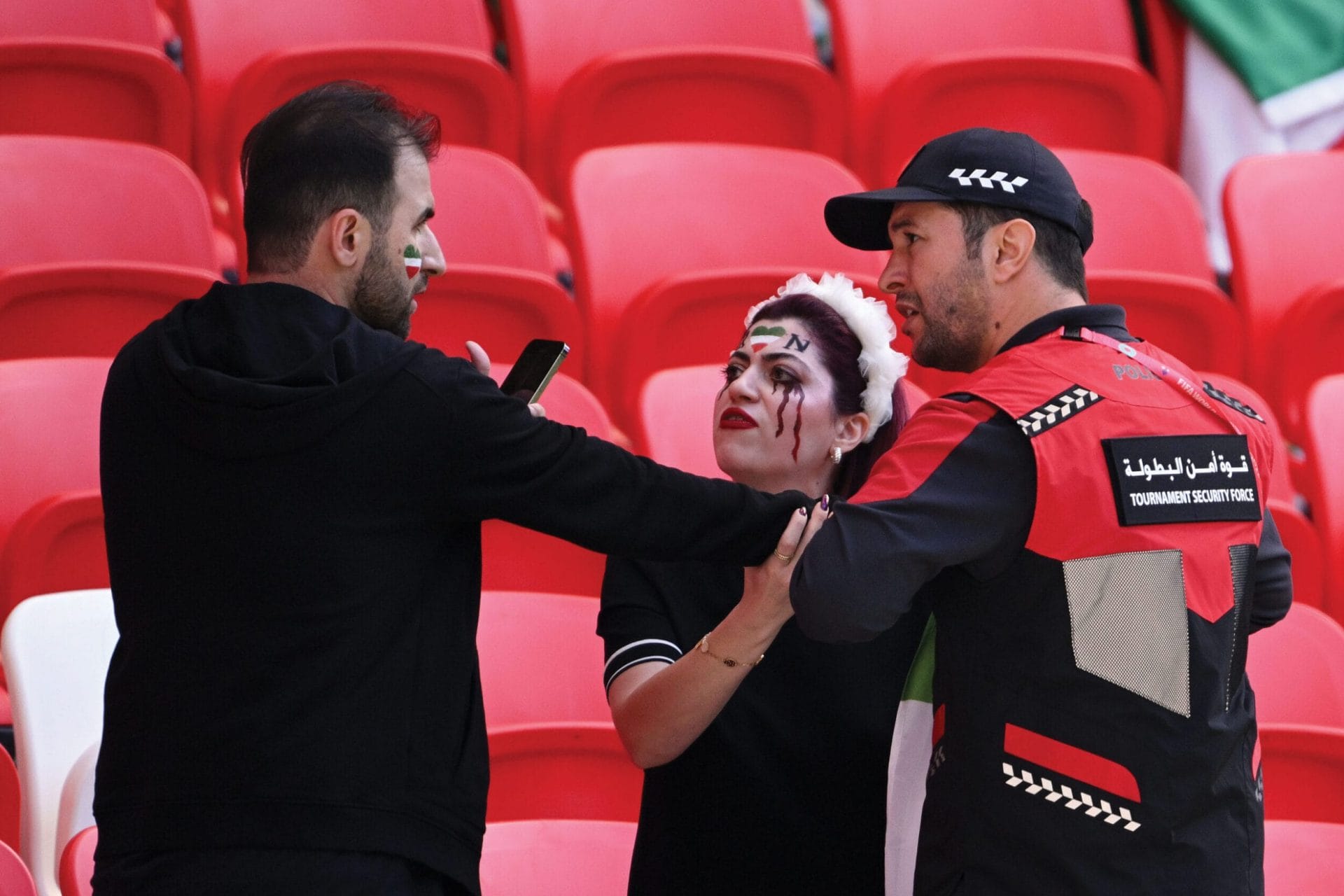
A member of security staff confronts fans at the Wales-Iran match, 25th November 2022. Photo: Matthias Hangst/Getty Images
On the pitch Iran scored twice in injury time to win 2-0 and add extra weight to one of the most politically charged games in world football, Iran vs the US. The winner would qualify for the next round. But Kamalinia had little time to celebrate. After the game he was arrested while trying to help a woman who had been stopped for wearing an anti-regime T-shirt. “We were detained for a good five hours after the Wales game,” he said. “We realised we were not dealing with what we expect from law enforcement.”
Iran v US, 29th November 2022
Kamalinia was still living in Tehran when Iran beat the US 2-1 at France 98. Iran had just elected reformist president Mohammad Khatami. The country was hopeful. When a million people took to the streets of the capital to celebrate the result, it was the first time large groups of women had been seen in public without a hijab since 1983. It was symbolic of Iran’s new-found optimism. But in 2022 many Iranians, including Kamalinia, thought the unthinkable. They wanted the US to win. “I went to the game knowing that I have no doubt that this is good for Iranian people to be defeated by the US,” says Kamalinia. Where once the team was seen as the champion of the people, now it only seemed to be the pro-government militias, who had been busy brutalising protesters, who celebrated the team’s progress on the streets in Iran.
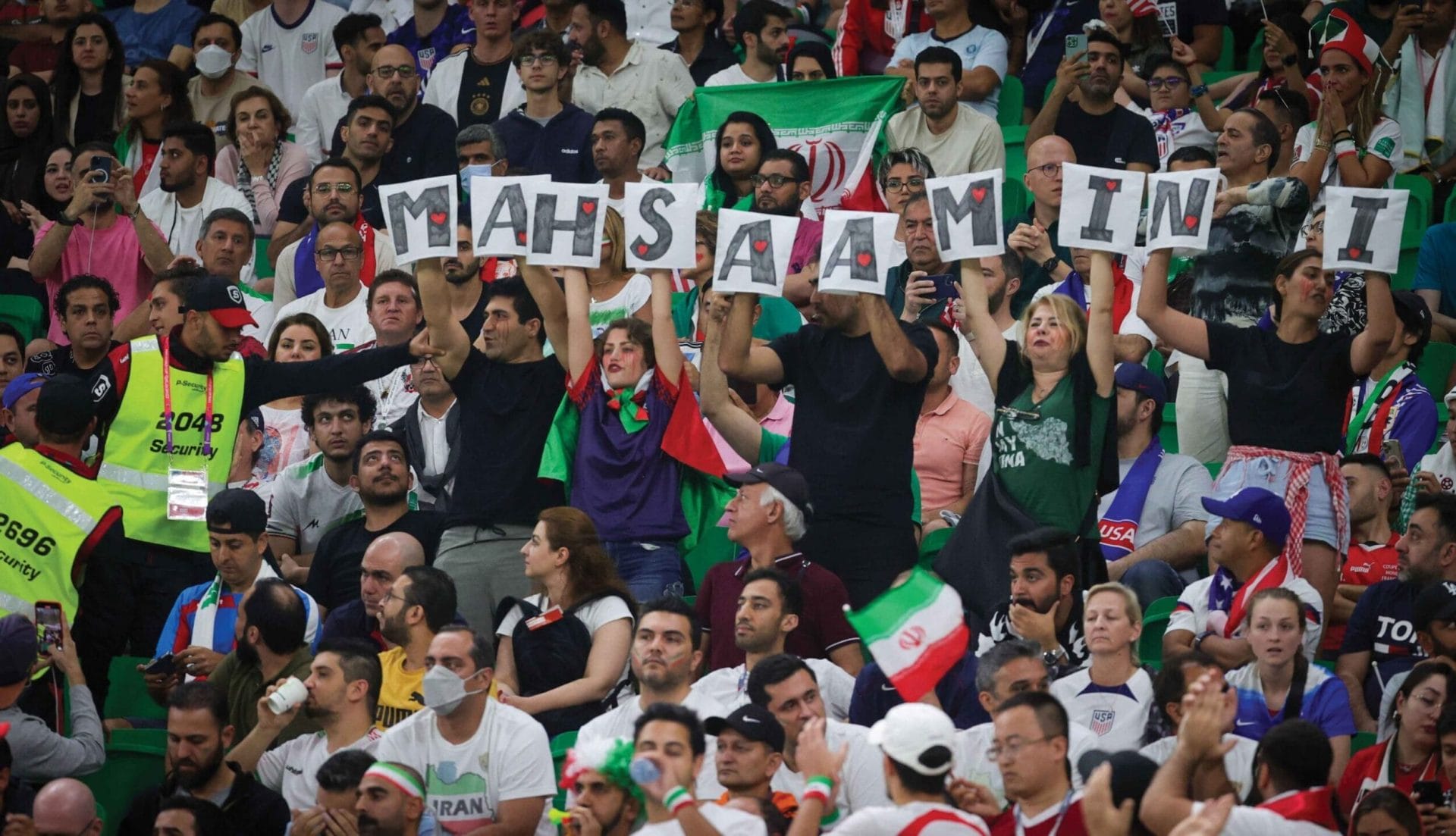
Security guards approach supporters, including Arman Jabbari, holding letters forming the name Mahsa Amini at the Iran vs US game, 29th November 2022. Photo: Virginie Lefour/Belga Mag/AFP via Getty Images
As night fell on the Al Thumama stadium in Doha, Iranian and American fans mixed freely outside. There were no Persian flags or Mahsa Amini banners openly on display. Anyone who wanted to protest had learned to be more subtle. The Iran players again went through the motions and mouthed the anthem. I was sitting with a large group of Iranian fans behind the goal when Christian Pulisic scored the opening goal for the US. Even if many anti-regime fans wanted Iran to lose, no Iranians dared celebrate the US goal. Three drummers walked up and down the stairs seemingly primed to drown out any chants, just in case. “They are all regime,” Sara texted me from the other side of the stadium. “We were in a section that was like 90 percent regime fans,” Kamalinia would later tell me. “It was a toxic atmosphere.”
But then, a few rows down, five Iranians stood up. Each had two A4-sized pieces of fabric with a letter on each, covered in painted hearts. Together, lined up, they spelled out the name Mahsa Amini. Within seconds they were surrounded by police and security personnel who grabbed the pieces of fabric as if they were grenades. “As soon as he [the security guard] reached us, he said: ‘Give them to me, or I’ll take you and there will be serious consequences’,” said Arman Jabbari. He and his friends had spent the night before making the Mahsa Amini letters by sticking bits of fabric together to create a ‘hand pocket’ for each letter. This way, Arman said, they could display their message more clearly. At the back of the stand, the security officers tried to hide behind a concrete column as they attempted to rip the sign to shreds. When they saw I was watching they turned their backs to hide what they were doing. Jabbari and his friends were so worried about being followed that they left early. “We waited for a moment when everyone was excited and standing during a corner for Iran, and then sneaked out,” he said. “We took the metro and switched trains multiple times to make sure we were not being followed.”
The US won 1-0. Iran was eliminated. In Kurdish cities and in parts of Tehran, thousands took to the streets to celebrate the defeat. “Iran is a country where people are very passionate about football. Now they are out in the streets in the [Kurdish] city of Sanandaj & celebrate the loss of their football team against US,” tweeted the Iranian activist Masih Alinejad, who lives in exile in America. “They don’t want the government [to] use sport to normalise its murderous regime.”
Outside, in the concourses around the stadium, fights broke out between pro- and anti-regime supporters. Kamalinia saw security guards violently dragging a group of fans who began chanting “Woman, Life, Freedom” away from the stadium. He also filmed a group of men who started beating up a boy, who looked no older than 13, and his family for holding an old Persian flag. The police, he said, ignored the evidence he showed them. They seemed less interested in his video of the men attacking a child than in confiscating contraband flags and signs. The lack of any police protection and the sheer number of pro-regime fans made Kamalinia feel “really unsafe”.
In Iran the uprising, and the deaths, continued. Carlos Queiroz’s contract with Iran ended with the defeat against the US. Two months later he was hired as the Qatar national team coach. The reputation of Iranian football and the national team had taken a beating. But Kamalinia, who left Qatar the day after the US game, was not ready to abandon Team Melli and believes the side could yet be a force for change. “To me, this is just like a fight between husband and wife,” he said of the tensions between fans and the national team. “It will be temporary, right?” Far from showing the regime’s strength, he believed, the violent crackdown, and the way Iran handled the World Cup with Qatar’s complicity, showed weakness. He thinks this was the last World Cup where the Islamic Republic of Iran will be represented. “I was born after the revolution, but I have seen a lot of things,” he said. “We went to war. At one point we thought there was reform. At this point, I think we just exhausted all those other alternatives. Things will change.”
And the players? Those under contract in Europe were allowed to return to their clubs. The Persian Gulf Pro League resumed in Iran, albeit without spectators allowed in the stadiums. The opaque and punitive nature of the regime means that it might be years until the true scale of the pressure and threats brought to bear on Iran’s footballers will be truly known. What we do know is that a dark new chapter has been opened. Executions of protesters began in December. One former professional player, Amir Nasr-Azadani, was initially sentenced to death for participating in the demonstrations. After an international outcry his sentence was reduced to 16 years in jail. The federation has even started punishing players for not celebrating goals vigorously enough, a perceived act of support for the protesters. Football in Iran will continue to be a dangerous game.
Slow Journalism in your inbox, plus infographics, offers and more: sign up for the free DG newsletter. Sign me up
Thanks for signing up.
